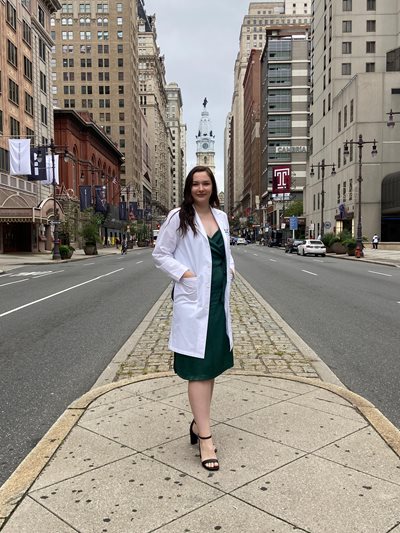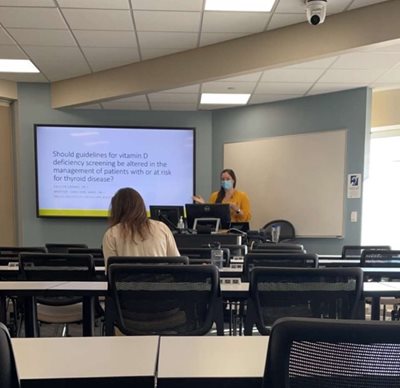January is Thyroid Awareness Month, and given the correlation Kaitlyn Carmo, MMS ‘21, made between thyroid disease and the amount of vitamin D we receive from sunlight during the research for her Physician Assistant (PA) Studies capstone project, it seems fitting.
For much of the world, especially the countries in the northern hemisphere, the cold, blistery weather of January brings with it little sunshine. This is exactly the type of weather, as Carmo explains, that sometimes requires vitamin D supplementation and monitoring for those with or at risk of thyroid disease.
 “Some of the research I found actually showed that people who live above a certain degree of latitude…almost everyone, especially during the winter months, have vitamin D deficiency,” she said. “One of the research articles I found actually showed that [vitamin D deficiency] had a strong correlation with thyroid disease. So, there was a connection, but more research needs to be done on what the connection actually is.”
“Some of the research I found actually showed that people who live above a certain degree of latitude…almost everyone, especially during the winter months, have vitamin D deficiency,” she said. “One of the research articles I found actually showed that [vitamin D deficiency] had a strong correlation with thyroid disease. So, there was a connection, but more research needs to be done on what the connection actually is.”
Carmo’s capstone project was titled “Should guidelines for vitamin D deficiency screening be altered in the management of patients with or at risk for thyroid disease?”
As someone who suffers from subclinical hypothyroidism herself, Carmo brought passion and curiosity to this project and hopes her findings can induce more research on the connection between vitamin D and thyroid disease. Hypothyroidism is a condition in which the thyroid doesn’t produce enough of the thyroid hormone.
“When I was thinking about what to do for the project, I was thinking about things that related to my own life,” she said. “And, subclinical hypothyroidism is when TSH (Thyroid Stimulating Hormone Test) is high, which is the screening for thyroid disease, but everything else seems to be normal - that's why it's called subclinical hypothyroidism.” As a patient with the same clinical diagnosis and with an interest in vitamin D deficiency, she wanted to see if there was a correlation between the two.
“I found research that showed there is a connection. How strong of a connection? It was a significant correlation, but there wasn't enough research that was replicated to show that, so more research needs to be done,” she said. "And, treating subclinical hypothyroidism and thyroid diseases that were autoimmune, the body kind of attacking itself, there was research done that showed since it was subclinical, maybe the patients weren't taking any treatment to start with for their thyroid disease, or they weren't having any symptoms, but just the lab markers showed that they had this. If they were treated with just vitamin D itself then it actually improved those lab markers, which was very interesting because that showed just replenishing and being sufficient with vitamin D can improve the markers of thyroid disease.”
So, what exactly is the right amount of vitamin D? That’s where Carmo said more research needs to be conducted. Adequate vitamin D levels range between 20 to 50 nanograms/milliliters and less than 12 ng/mL indicates a deficiency. According to Dr. Daniel Pavlik, PA program director, technically below 20 ng/mL is considered deficient but 12 ng/mL is the threshold where interventions would occur.
“More research needs to be done to make a benchmark number to say how much vitamin D is needed because all the research used different vitamin D amounts and symptoms are very subjective, so it's hard to say whether this improved patients’ lives as well. But just showing that the lab markers improved in subclinical hypothyroidism and autoimmune thyroid disease was really cool to see,” she said.
 But what Carmo’s early findings did show was that the population over a particular latitude is the most vitamin D deficient. These are the people who could potentially benefit most from more data becoming available on the connection between vitamin D and thyroid disease. “It's 37 degrees latitude, so it would be around Virginia, it would include basically the entirety of Europe, but in the United States, it's the line that runs right across Tennessee…So more than half of the United States,” she said.
But what Carmo’s early findings did show was that the population over a particular latitude is the most vitamin D deficient. These are the people who could potentially benefit most from more data becoming available on the connection between vitamin D and thyroid disease. “It's 37 degrees latitude, so it would be around Virginia, it would include basically the entirety of Europe, but in the United States, it's the line that runs right across Tennessee…So more than half of the United States,” she said.
Carmo hopes if more data becomes available regarding this topic that it will lead to updated preventative screening guidelines, which don’t currently cover vitamin D as a routine lab marker.
“That's one of the biggest reasons that I wanted to bring attention to it because most people don't get their vitamin D labs drawn because it's not suggested unless you're having symptoms, but the whole basis of my project was subclinical hypothyroidism. You aren't showing symptoms,” Carmo said. “So, if you could prevent diseases from happening before it becomes significant — I think preventative medicine needs more of an emphasis. Currently vitamin D screening is not suggested by the United States preventative task force because there's no agreed upon lab marker for what is actually vitamin D deficient and no proven research to say that you have to be above a certain amount to be ‘sufficient.’ But thyroid disease wasn't examined in that review, so just to change guidelines to say we should look at vitamin D deficiency with thyroid disease, I think that should be the next step for research, ‘Hey, there's a correlation. What does this mean?’”
Carmo warns it’s not as easy as most people think to get the proper amount of vitamin D, especially in northern states like Pennsylvania. In these states, it’s really only the summer months that allow for significant vitamin D absorption through the sun. And even then, if you’re wearing sunblock or covering your skin with clothing, you’re not absorbing the sun. While protection from the sun is also important, these hurdles are what Carmo says puts even more emphasis on vitamin D supplementation.
“It's only a short amount of time, especially in Pennsylvania, that you would actually be able to get enough vitamin D to be sufficient,” Carmo said. “So, supplementing or just trying to get enough from your diet — getting enough in your diet is hard enough because there are only certain foods that would have vitamin D in it — but supplementing with a multivitamin is the best way to go.”